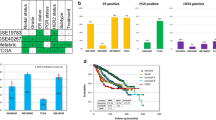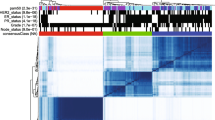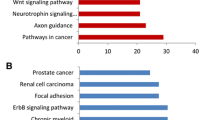Abstract
The aim of this study was to investigate whether lymph node involvement in breast cancer is influenced by gene or miRNA expression of the primary tumor. For this purpose, we selected a very homogeneous patient population to minimize heterogeneity in other tumor and patient characteristics. First, we compared gene expression profiles of primary tumor tissue from a group of 96 breast cancer patients balanced for lymph node involvement using Affymetrix Human U133 Plus 2.0 microarray chip. A model was built by weighted Least-Squares Support Vector Machines and validated on an internal and external dataset. Next, miRNA profiling was performed on a subset of 82 tumors using Human MiRNA-microarray chips (Illumina). Finally, for each miRNA the number of significant inverse correlated targets was determined and compared with 1000 sets of randomly chosen targets. A model based on 241 genes was built (AUC 0.66). The AUC for the internal dataset was 0.646 and 0. 651 for the external datasets. The model includes multiple kinases, apoptosis-related, and zinc ion-binding genes. Integration of the microarray and miRNA data reveals ten miRNAs suppressing lymph node invasion and one miRNA promoting lymph node invasion. Our results provide evidence that measurable differences in gene and miRNA expression exist between node negative and node positive patients and thus that lymph node involvement is not a genetically random process. Moreover, our data suggest a general deregulation of the miRNA machinery that is potentially responsible for lymph node invasion.



Similar content being viewed by others
References
Shek LL, Godolphin W (1988) Model for breast cancer survival: relative prognostic roles of axillary nodal status, TNM stage, estrogen receptor concentration, and tumor necrosis. Cancer Res 48:5565–5569
Weigelt B, Peterse JL, van‘t Veer LJ (2005) Breast cancer metastasis: markers and models. Nat Rev Cancer 5(8):591–602
Jatoi I, Hilsenbeck SG, Clark GM, Osborne CK (1999) Significance of axillary lymph node metastasis in primary breast cancer. J Clin Oncol 17(8):2334–2340
Mittra I, MacRae KD (1991) A meta-analysis of reported correlations between prognostic factors in breast cancer: does axillary lymph node metastasis represent biology of chronology? Eur J Cancer 27(12):1574–1583
Fisher B, Jeong JH, Anderson S, Bryant J, Fisher ER, Wolmark N (2002) Twenty-five-year follow-up of a randomized trial comparing radical mastectomy, total mastectomy, and total mastectomy followed by irradiation. N Engl J Med 347(8):567–575
Koscielny S, Le MG, Tubiana M (1989) The natural history of human breast cancer. The relationship between involvement of axillary lymph nodes and the initiation of distant metastases. Br J Cancer 59:775–782
Yip CH, Taib NA, Tan GH, Ng KL, Yoong BK, Choo WY (2009) Predictors of axillary lymph node metastases in breast cancer: is there a role for minimal axillary surgery? Word J Surg 33:54–57
Rivadeneira DE, Simmons RM, Christos PJ, Hanna K, Daly JM, Osborne MP (2000) Predictive factors associated with axillary lymph node metastases in T1a en T1b breast carcinomas: analysis in more than 900 patients. J Am Coll Surg 191(1):1–6
Wildiers H, Van Calster B, van de Poll-Franse LV et al (2009) Relationship between age and axillary lymph node involvement in women with breast cancer. J Clin Oncol 27(18):2931–2937
Sotiriou C, Pusztai L (2009) Gene-expression signatures in breast cancer. N Engl J Med 360:790–800
Huang E, Cheng SH, Dressman H et al (2003) Gene expression predictors of breast cancer outcomes. Lancet 361(9369):1590–1596
Weigelt B, Wessels LFA, Bosma AJ et al (2005) No common denominator for breast cancer lymph node metastasis. Br J Cancer 93(8):924–932
He L, Hannon GJ (2004) MicroRNAs: small RNAs with a big role in gene regulation. Nat Rev Genet 5(7):522–531
Ng EK, Wong CLP, Ma ES, Kwong A (2009) MircroRNAs as new players for diagnosis, prognosis and therapeutic targets in breast cancer. J Oncol 2009:305420
Heneghan HM, Miller N, Kerin MJ (2010) MiRNAs as biomarkers and therapeutic targets in cancer. Curr Opin Pharmacol 10:1–8
Martinez-Ramos D, Escrig-Sos J, Alcalde-Sanchez M, Torrela-Ramos A, Salvador-Sanchis JL (2009) Disease-free survival and prognostic significance of metastatic lymph node ratio in T1–T2 N positive breast cancer patients. A population registry-based study in a European country. World J Surg 33:1659–1664
Suykens JAK, Van Gestel T, De Brabanter J, De Moor B, Vandewalle J (2002) Least squares support vector machines. World Scientific, Singapore
Suykens JAK, Vandewalle J (1999) Least squares support vector machine classifiers. Neural Process Lett 9:293–300
Cawley GC (2006) Leave-one-out cross-validation based model selection criteria for weighted LS-SVMs. Proc Int Joint Conf Neural Netw 1661–1668
Berezikov E, vanTetering G, Verheul M et al (2006) Many novel mammalian microRNA candidates identified by extensive cloning and RAKE analysis. Genome Res 16:1289–1298
Betel D, Wilson M, Gabow A, Marks DS, Sander C (2008) The microRNA.org resource: targets and expression. Nucleic Acids Res 36:D149–D153
Zhang B, Schmoyer D, Kirov S, Snoddy J (2004) GOTree Machine (GOTM): a web-based platform for interpreting sets of interesting genes using Gene Ontology hierarchies. BMC Bioinformatics 5:16
Subramanian A, Tamayo P, Mootha VK et al (2005) Gene set enrichment analysis: a knowledge-based approach for interpreting genome-wide expression profiles. Proc Natl Acad Sci U S A 102(43):15545–15550
Hu M, Polyak K (2008) Microenvironmental regulation of cancer development. Curr Opin Genet Dev 18(1):27–34
van Kempen LCLT, Ruiter DJ, van Muijen GNP, Coussens LM (2003) The tumor microenvironment: a critical determinant of neoplastic evolution. Eur J Cell Biol 82(11):539–558
Bogenrieder T, Herlyn M (2003) Axils of evil: molecular mechanisms of cancer metastasis. Oncogene 22(42):6524–6536
Sheu BC, Kuo WH, Chen RJ, Huang SC, Chang KJ, Chow SN (2008) Clinical significance of tumor-infiltrating lymphocytes in neoplastic progression and lymph node metastasis of human breast cancer. Breast 17(6):604–610
Macchetti AH, Marana HRC, Silva JS, de Andrade JM, Ribeiro-Silva A, Bighetti S (2006) Tumor-infiltrating CD4+T lymphocytes in early breast cancer reflect lymph node involvement. Clinics 61(3):203–208
Simon R (2005) Roadmap for developing and validating therapeutically relevant genomic classifiers. J Clin Oncol 23(29):7332–7341
Michiels S, Koscielny S, Hill C (2007) Interpretion of microarray data in cancer. Br J Cancer 96(8):1155–1158
Ding WQ, Yu HJ, Lind SE (2008) Zinc-binding compounds induce cancer cell death via distinct modes of action. Cancer Lett 271(2):251–259
Wang L, Baiocchi RA, Pal S, Mosialos G, Caligiuri M, Sif S (2005) The BRG1- and hBRM-associated factor BAF57 induces apoptosis by stimulating expression of the cylindromatosis tumor suppressor gene. Mol Cell Biol 25(18):7953–7965
Apte RN, Dotan S, Elkabets M et al (2006) The involvement of IL-1 in tumorigenesis, tumor invasiveness, metastasis and tumor-host interactions. Cancer Metastasis Rev 25(3):387–408
Zhang C, Chakravarty D, Sakabe I et al (2006) Role of SCC-S2 in experitmental metastasis and modulation of VEGFR-2, MMP-1, an d MMP-9 expression. Mol Ther 13(5):947–955
Németh J, Stein H, Haag D et al (2009) S100A8 and S100A9 are novel nuclear factor kappa B target genes during malignant progression of murine and human liver carcinogenesis. Hepatology 50(4):1251–1262
Kanda M, Nomoto S, Nishikawa Y et al (2008) Correlations of the expression of vascular endothelial growth factor B and its isoforms in hepatocellular carcinoma with clinico-pathological parameters. J Surg Oncol 98(3):190–196
Fan F, Wey JS, McCarty MF et al (2005) Expression and foundation of vascular endothelial growth factor receptor-1 on human colorectal cancer cells. Oncogene 24(16):2647–2653
Wey JS, Fan F, Gray MJ et al (2005) Vascular endothelial growth factor receptor-1 promotes migration and invasion in pancreatic carcinoma cell lines. Cancer 104(2):427–438
Gunningham SP, Currie MJ, Han C et al (2001) VEGF-B expression in human primary breast cancers is associated with lymph node metastasis but not angiogenesis. J Pathol 193(3):325–332
Hiratsuka S, Watanabe A, Aburatani H, Maru Y (2006) Tumour-mediated upregulation of chemoattractants and recruitment of myeloid cells predetermines lung metastasis. Nat Cell Biol 8(12):1369–1375
Van’t Veer L, Dai H, van de Vijver M et al (2002) Gene expression profiling predicts clinical outcome of breast cancer. Nature 415(6871):530–536
Hao X, Sun B, Hu L et al (2004) Differential gene and protein expression in primary breast malignancies and their lymph node metastases as revealed by combined cDNA microarray and tissue microarray analysis. Cancer 100(6):1110–1122
Nishidate T, Katagiri T, Lin ML et al (2004) Genome-wide gene-expression profiles of breast-cancer cells purified with laser microbeam microdissection: identification of genes associated with progression and metastasis. Int J Oncol 25(4):797–819
Li X, Cao X, Li X, Zhang W, Feng Y (2007) Expression level of insulin-like growth factor binding protein 5 mRNA is a prognostic factor for breast cancer. Cancer Sci 98(10):1592–1596
Abdelmohsen K, Kim MM, Srikantan S, et al. (2010) miR-519 suppresses tumor growth by reducing HuR levels. Cell Cycle 9(7):1538–4101
Yang N, Kaur S, Volinia S et al (2008) MicroRNA microarray indentifies Let-7i as a novel biomarker and therapeutic target in human epithelial ovarian cancer. Cancer Res 68(24):10307–10314
Bhattacharya R, Nicoloso M, Arvizo R et al (2009) MiR-15a and MiR-16 control Bmi-1 expression in ovarian cancer. Cancer Res 69(23):9090–9095
Tsukamoto Y, Nakada C, Noguchi T et al (2010) Micro-RNA-375 Is downregulated in gastric carcinomas and regulates cell survival by targeting PDK1 and 14–3-3. Cancer Res 70(6):2339–2349
Arndt GM, Dossey L, Cullen LM et al (2009) Characterization of global microRNA expression reveals oncogenic potential of miR-145 in metastatic colorectal cancer. BMC Cancer 9:374
Villanueva A, Hoshida Y, Toffanin S et al (2010) New strategies in Hepatocellular carcinoma: genomic prognostic markers. Clin Cancer Res 16(19):4688–4994
Acknowledgment
AS is supported by a grant from Research Foundation Flanders (FWO) and Pfizer Oncology.
Author information
Authors and Affiliations
Corresponding author
Electronic supplementary material
Below is the link to the electronic supplementary material.
Rights and permissions
About this article
Cite this article
Smeets, A., Daemen, A., Vanden Bempt, I. et al. Prediction of lymph node involvement in breast cancer from primary tumor tissue using gene expression profiling and miRNAs. Breast Cancer Res Treat 129, 767–776 (2011). https://doi.org/10.1007/s10549-010-1265-5
Received:
Accepted:
Published:
Issue Date:
DOI: https://doi.org/10.1007/s10549-010-1265-5




